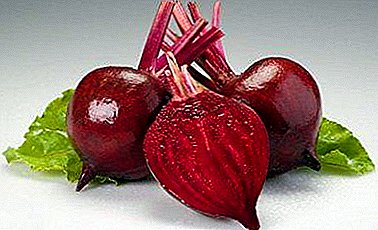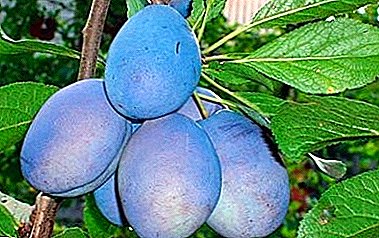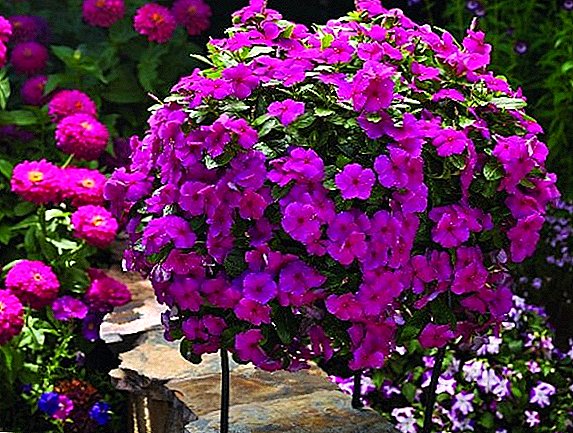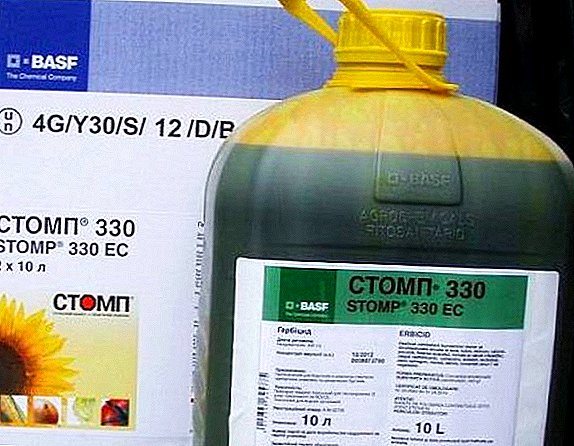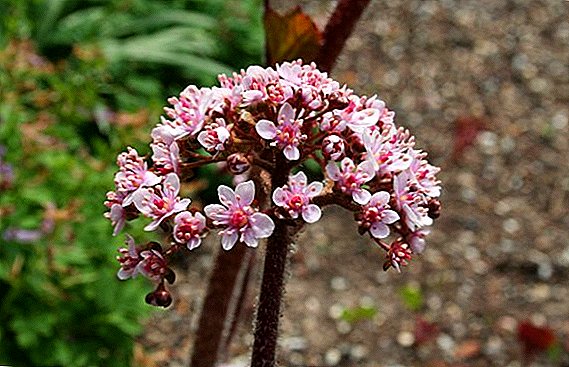 Blue color is a rare guest in the garden farms of our country. It is connected first of all with the fact that cold shades, including blue and blue, attract insects worse, respectively, fewer insects sit on flowers of this color, and they are less pollinated. In this article you can find information about blue garden colors, their photos and names.
Blue color is a rare guest in the garden farms of our country. It is connected first of all with the fact that cold shades, including blue and blue, attract insects worse, respectively, fewer insects sit on flowers of this color, and they are less pollinated. In this article you can find information about blue garden colors, their photos and names.
Scilla
These blue colors are sometimes mistakenly given the names of Lust and Prolesnik, below in the photo you can evaluate their external parameters. This low perennial is very undemanding to the conditions of growth, multiplies well and is immune to diseases and pests.
Did you know? Scilla is used in traditional medicine. Her dried flowers are included in the composition of infusions against colds and flu.This plant is often confused with a snowdrop, because they make their way almost simultaneously. It has long leaves with a parallel veining, the root is an onion, and the flowers have ray symmetry, contain six petals and stamens and one pistil. The fruit is a box with many small seeds.

Clematis
There are many different types of this flower. There are bushes, grassy perennials, but an absolute majority are climbing vines. Their color range is not limited to only blue shades, including also yellow, red, pink and orange colors.
You will be interested to get acquainted with the varieties of clematis.Clematis leaves are complex (including 3, 5 or 7 small leaves) or simple, as a rule, green and paired. Flowers can be collected in inflorescences of various forms (shield, half-cusp, panicle), contain quite variable number of petals: from 4 to 8, and in some forms up to 70.
In the center of the flower are many stamens and pestles. The fragrance exuded by clematis has a similarity with primrose, almond and jasmine. 
Hydrangea
In total, there are about 80 species of this flower: from vines and shrubs to small trees. Hydrangeas can be of different colors: blue, white, pale pink, dark purple, red and cream.
Description of the types and varieties of hydrangeas.This flower can be both deciduous and evergreen, but the first variant is more common in our latitudes.
Did you know? If desired, the color of the hydrangea can be changed by regulating the acidity of the soil and the amount of aluminum contained in it.Hortensia is rather large, oval-shaped, with sharp ends of leaves with a slightly noticeable venation. It blooms for quite a long period: from spring to late autumn.
The flowers are collected in inflorescences of various shapes: an umbrella, a ball or a whisk, each has 4 petals, in the center there are pistils and stamens. The fruit is a box with a large number of small seeds. 
Lobelia
Lobelia is a herbaceous perennial flower from the bell family; you can see its appearance in the photo. The most popular type in ornamental gardening is lobelia erinus, also known as lobelia blue and lobelia garden.
Bushes lobelia compact spherical shape, a height of 10-25 cm. The leaves are small, lanceolate, arranged in a regular manner, whole. Flowers up to 2 cm in diameter, placed on short legs, each in a separate sinus, up to 2 cm in diameter.
It will be interesting to you - the description of popular varieties of lobelia.Color varies depending on the variety: blue, purple, dark blue, white, etc. Blossoms from June until September. The flowering period can be prolonged by removing the faded stems. The fruit is a seed box with a huge amount of seeds (in 1 g - 50 thousand seeds).

Aconite
Aconite is a perennial blue flower, also known as a wrestler, a wolf and a skullcap, with the look of a plant you can see the presented photo It grows, as a rule, in places rich in moisture and humus.
Important! Aconite is a plant that is poisonous to humans, so it is worth taking precautions when growing it.It has alternate leaves of a round shape, less or deeper footed. The stem is straight, 30-40 cm long. The inflorescences are a apical brush, which consists of flowers of rather large sizes.
Popular varieties of aconite.Flowers of irregular coronoid shape, have a five-leafed cup, which may have a blue, white, lilac or yellow color, in the center there are many stamens and one pistil. Fruit - from 3 to 7 dry leaflets with a large number of seeds.

Forget-me-not
This blue garden flower is well known to all residents of the post-Soviet space by the eponymous song by Vyacheslav Dobrynin. It is an annual or perennial herbaceous plant of rather small size, often heavily pubescent.
Features of the cultivation and care of forget-me-nots.Stems reach sizes from 10 to 40 cm, have a highly developed branching structure. Leaves lanceolate or spatulate, sessile, alternate.
The flowers are blue with a yellow spot in the center, usually formed into an inflorescence (curl or brush), consist of a five-lobe calyx and a dish-shaped corolla, in the center there is one pistil and five stamens. The fruit is a cobble, which, after maturation, disintegrates into four parts that are not welded together. 
Bells
This plant can mainly be found in latitudes with a temperate climate. Its Latin name - Campanula, as well as Russian, appeals to its form and translates as a bell. Extremely undemanding conditions of detention.
A selection of the most popular varieties of bells.The stem is narrow, straight, up to 1.5 meters long. The leaves are alternately small, elongated, lanceolate. Inflorescences are often racemose or paniculate, sometimes one-flowered.
The flowers, as the name implies, are bell-shaped, rather large (up to 7 cm), in the center there are three stamens and one pistil. The color varies from blue, purple and blue to white and purple. 
Geranium
Geranium, also known as pelargonium, has about 400 different plant species, usually represented by shrubs and herbs. These small blue flowers are also called the crane because of the shape of their fruits, which resemble the crane's beak.
The stem is curved, up to 1 meter long. The leaves are located on the petioles extending from the stem, dissected in a variety of ways, palchatolopastnye or palchatorazdelnye, sometimes feathery form with three to five leaves.
Learn how to care for geraniums.Some species have soft hairs. Peduncle contains from one to three flowers of the correct form, rather large sizes, each of which consists of a five-leafed calyx and five petals of a round corolla, in the center there are up to 10 stamens, each with an anther.

Petunia
Petunia is a plant from the family of hairy, the main habitat of which is South America. Hybrid forms, grown as annual crops in pots, were fallen in love with gardeners for their unsuited color and rather large, attractive flowers.
How to choose a petunia for the garden - varieties of flowers.The stem is straight, from 20 to 70 cm long. The leaves are alternate, sessile, of different sizes and shapes, pubescent, entire. The flowers are very large, often solitary, as a rule, have a rather unpleasant odor; the calyx consists of five leaves, which have grown together at the base 1/6 of the length, the rim is five-petal, either regular or star-shaped.
In the center of the flower - four or five stamens. The fruit is a bivalve capsule that unfolds after a flowering period. 
knapweed
This flower is considered weedy and is often found on fields, forest edges, vegetable gardens and fields. Cornflower is an annual or biennial plant that is quite rarely seen as cultivated in the garden, so you can pretty much surprise your guests by including it in one of your flower ensembles.
We reveal the secrets of growing cornflowers in the garden.This flower has a straight, rough stem with a length of 20-100 cm. Lanceolate leaflets, tightly seated on the stem, lowered. Flower baskets crowned the top of the stem, large, single, have a fringed edge, marginal flowers in baskets are of the brightest color, barren, internal ones are less bright, contain several stamens and one pistil.
Fruit - achene with red tuft, which is almost equal to it in length. 
Lavender
Lavender in ancient times was used for the process of ablution of the body, which is hinted at by the root of its name - lava, which from Latin means “wash”. Today, only two species of this plant are widely distributed in the world - broadleaf lavender (for ornamental purposes) and narrow-leaved lavender (as medicinal raw materials).
This evergreen perennial has numerous stems that lignify in the root part and reach a length of 60 cm. The leaves are oppositely sessile, silver-greenish in color with soft pubescence.
Medicinal properties of lavender in folk medicine.The flowers are small, blue or blue-lilac, gather in spike-shaped inflorescences of 6-10 pieces, have 5 petals, in the center are located 3-5 stamens. The fruit consists of four nut-like formations that are inside the cup.

Delphinium
This plant is quite close in its biological parameters to another character of this article - aconite. Also known under the name of larkspur and bass. It includes about 450 different species, mostly native to the northern hemisphere.
The tricks of growing delphinium on your site.The height of the stem varies from 10 cm to 3 meters. Leaflets - palmate-divided, as a rule, deeply and in many places dissected into sharp or serrated lobes. Flowers of irregular shape gather in inflorescences paniculate form, each of which has 3-15 flowers.
 Each flower consists of five sepals, the top one has a special cone-shaped spur. Fruits - mnogolistvki.
Each flower consists of five sepals, the top one has a special cone-shaped spur. Fruits - mnogolistvki.Important! Most species of delphinium are poisonous plants that pose a danger not only to humans, but also to bees and livestock.If you decide to diversify your flower beds with blue flowers, remember that some of them are poisonous, but if you follow the precautionary rules, even dangerous species will not have to give you any particular trouble. We wish you successful landscape changes and the most beautiful flower ensembles!




